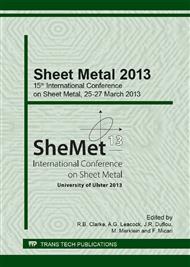p.381
p.389
p.397
p.407
p.415
p.423
p.429
p.436
p.444
Determination of Friction in Sheet Metal Forming by Means of Simulative Tribo-Tests
Abstract:
Numerical modeling of complex sheet stamping operations is well developed and implemented in industry. The weakest link now seems to be appropriate modeling of friction and to some extent also material properties especially when it comes to new lubricants and materials. In modeling of 3-D stamping operations a coefficient of friction μ is often determined by calibration of the simulation results with experimental observations of material flow and/or measured load. In case of modeling of new stamping operations μ is typically selected based on former experience. These procedures are, however, not appropriate when introducing new tribo-systems (lubricant, workpiece material, tool material or tool coating). In order to determine friction under the very varied conditions in sheet stamping simulative testing may be applied, e.g., Plane-Strip-Testing (PST), Draw-Bead-Testing (DBT) and Bending-Under-Tension testing (BUT) but these tests should be analyzed and carefully tuned with the production process in question to ensure useful results. The present paper illustrates how the BUT test combined with classical analytical modeling may lead to very large errors in estimation of the coefficient of friction, whereas detailed numerical simulation of the test can give useful friction values as demonstrated in comparative analysis of an industrial, multistage deep drawing.
Info:
Periodical:
Pages:
415-422
Citation:
Online since:
April 2013
Authors:
Price:
Сopyright:
© 2013 Trans Tech Publications Ltd. All Rights Reserved
Share:
Citation:


